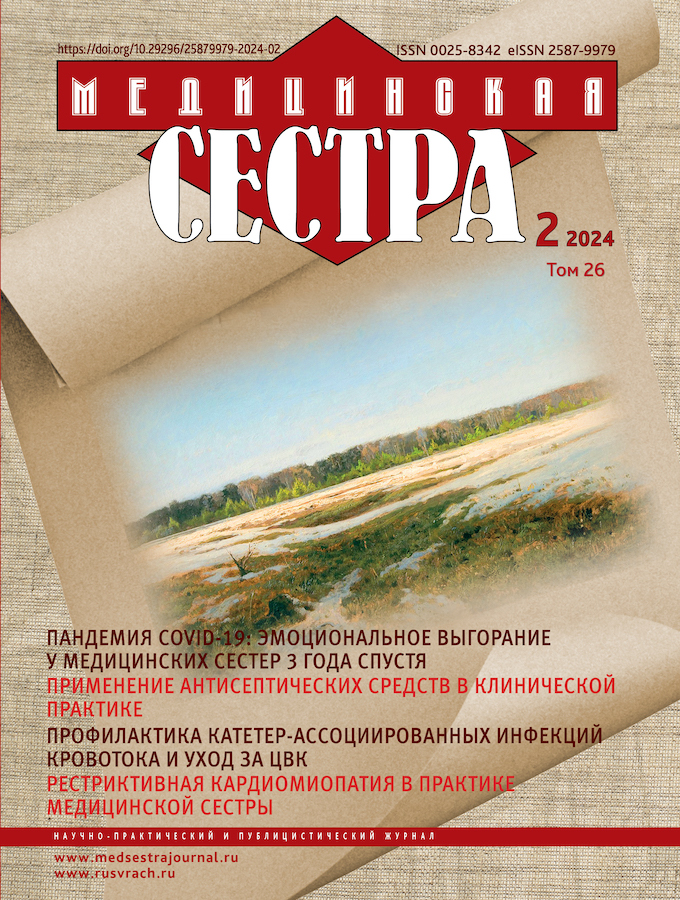Restrictive cardiomyopathy in nurse practice
- Authors: Skvortsov V.V.1, Belyakova E.V.1, Eremenko A.A.1, Eremenko N.V.1
-
Affiliations:
- Federal State Budgetary Educational Institution of Higher Education “Volgograd state medical university” of the ministry of health of the Russian Federation
- Issue: Vol 26, No 2 (2024)
- Pages: 47-50
- Section: Profession: theory and practice
- URL: https://journals.eco-vector.com/0025-8342/article/view/629542
- DOI: https://doi.org/10.29296/25879979-2024-02-10
- ID: 629542
Cite item
Abstract
Cardiomyopathy (CMP) is a group of heterogeneous diseases characterized by structural or functional changes in the myocardium, not caused by coronary heart disease, hypertension, valvular diseases and congenital diseases. This article deals with problems of etiology, pathogenesis, clinical symptomatology, approaches to detection and treatment of restrictive cardiomyopathy.
Full Text
About the authors
Vsevolod V. Skvortsov
Federal State Budgetary Educational Institution of Higher Education “Volgograd state medical university” of the ministry of health of the Russian Federation
Author for correspondence.
Email: vskvortsov1@ya.ru
ORCID iD: 0000-0002-2164-3537
Doctor of Medicine, Associate Professor of the Department of Internal Medicine
Russian Federation, VolgogradElena V. Belyakova
Federal State Budgetary Educational Institution of Higher Education “Volgograd state medical university” of the ministry of health of the Russian Federation
Email: kursheva.elena.volg@rambler.ru
Candidate of Medical Sciences, Associate Professor of the Department of Internal Medicine
Russian Federation, VolgogradAndrey Andreevich Eremenko
Federal State Budgetary Educational Institution of Higher Education “Volgograd state medical university” of the ministry of health of the Russian Federation
Email: reak.froman@mail.ru
ORCID iD: 0000-0001-8361-9922
clinical resident
Russian Federation, VolgogradNatalia V. Eremenko
Federal State Budgetary Educational Institution of Higher Education “Volgograd state medical university” of the ministry of health of the Russian Federation
Email: missis.yasko@mail.ru
ORCID iD: 0000-0003-2596-7958
clinical resident
Russian Federation, VolgogradReferences
- Blagova O.V., Nedostup A.V. Classification of non-coronary heart diseases: our view of the problem. Russian Cardiology Journal, 2017; 2 (142): 7‒21.
- Blagova O.V., Nedostup A.V., Sedov V.P. Clinical masks of amyloidosis with heart lesions: features of diagnostics at the present stage. Russian cardiologic journal, 2017; 2 (142): 68‒79.
- Braunwald’s Diseases of the Heart, edited by P. Libby. Volume 4. Moscow, Logosphere, 2015; 1976‒1986.
- Kumar V. Fundamentals of disease pathology according to Robbins and Cottran. Moscow, Logosphere; 2016: 655‒660.
- Leontieva I.V., Nikolaeva E.A. Cardiomyopathies in congenital metabolic disorders in children. Russian gestnik perinatologii i pediatria, 2, 2016.
- Lilly L. Pathophysiology of the cardiovascular system. Binom. Laboratory of Knowledge, 2016. 383‒396; 526.
- Frolov V.A. Non-coronagenic myocardial diseases. Study guide. Practical Medicine; 2016: 23‒31.
- Seguela PE, et al. Eosinophilic cardiac disease: molecular, clinical and imaging aspects. Arch. cardiovascular disease. 2015; 108 (4): 258–268.
- Gregory Ho., Ed Peng et al. Restictive cardiomyopathy or constrictive pericarditis: an unresolved conundrum. World Journal for Pediatric and Congenital Heart Surgery, 2017; 9: 360–363.
- Jay Brieler, Matthew A. Breeden. Cardiomyopathy: an overview. American Family Physician, 2017; 96 (10): 640–646.
- F. Rodriguez-Mora, A. Adsuar-Gomez. Short-term Use of Ventricular Assist Device in a Patient with Restrictive Cardiomyopathy: A Case Report. Transplantation Proceedings, 2018; 50 (I. 2): 653–654.
- Zhang Y, MacCosham A. Mind the Gap: Genetic Variation and Personalized Therapies for Cardiomyopathies. Lifestyle Genom. 2018; (19): 1–3.
- Anderson H.N, Cetta F., Driscoll D.J., Olson T.M. Idiopathic Restrictive Cardiomyopathy in Children and Young Adults. The American Journal of Cardiology, 121 (10): 1266–1270.
- Marec J. et al. Comparison of echocardiographic parameters in Fabry cardiomyopathy and light-chain cardiac amyloidosis. Echocardiography. 2018; 35 (11): 1755–1763.
- Maleszewski JJ. Cardiac amyloidosis: pathology, nomenclature and typing. Cardiovascular Pathology. 2015; 24 (6): 343–350.
- Sperry BW, Tang WHW. Amyloid heart disease: genetics translated into disease-modifying therapy. Heart, 2017; 103 (11): 812–817.
- Hong JA, et al. Clinical features of Idiopathic Restrictive Cardiomyopathy: A retrospective multicenter cohort study over 2 decades. Medicine (Baltimore). 2017; 96 (36): 7886.
- Muchtar E. et al. Restrictive Cardiomyopathy: Genetics Pathogenesis, Clinical Manifestations, Diagnosis and Therapy. Circulation Research, 2017; (121): 819–837.
Supplementary files






